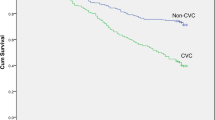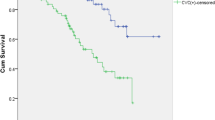Abstract
Background
Cardiovascular events (CVE) are the leading cause of death in peritoneal dialysis (PD) patients. The predictive value of cardiac valve calcification (CVC) for CVE in dialysis patients remains controversial. In particular, such studies are limited in PD patients. We aimed to examine the predictive role of CVC for CVE and cardiovascular mortality in PD patients.
Methods
A retrospective analysis was performed on patients who initiated PD in our hospital. According to the result of echocardiography, patients were divided into CVC group and non-CVC group. The differences in baseline demographic characteristics, biochemical variables, comorbidities, and clinical outcomes between the two groups were compared. Kaplan–Meier method was used to obtain survival curves. The Cox regression model was used to evaluate the influence of CVC for cardiovascular outcomes. The inverse probability of treatment weighting (IPTW) was used to eliminate influence of the confounders in the groups.
Results
458 peritoneal dialysis patients were enrolled in this study. 77 patients were in CVC group and 381 patients in non-CVC group. The average follow-up time was (32 ± 21) months. At baseline, the absolute standardized difference (ASD) of age, BMI, history of CVE, diabetes, LVEF, LVMI, albumin, calcium, phosphorus, triglycerides, hsCRP, urine volume, Kt/V, statins and vitamin D intake rate were greater than 0.1 between the two groups. All of ASD dropped to less than 0.1 after IPTW, which meant that the balance had been reached between the two groups. Multivariable logistic analysis showed that advanced age, diabetes, and hyperphosphatemia were associated with CVC. The Kaplan–Meier survival curve showed the cumulative CVE-free survival rate and cardiovascular survival rate of CVC group were significantly lower than that of non-CVC group before and after IPTW (log-rank P < 0.05). After IPTW was used to eliminate the effect of confounders, multivariate Cox regression analysis still showed CVC was an independent risk factor for CVE (HR = 2.383, 95% CI 1.331~4.264, P = 0.003) and cardiovascular mortality (HR = 2.347, 95% CI 1.211~4.548, P = 0.012) in PD patients.
Conclusion
The prevalence of CVC is high in peritoneal dialysis patients. CVC is an independent risk factor for CVE and cardiovascular mortality in peritoneal dialysis patients.



Similar content being viewed by others
References
Liu X, Hu Z, Xu X et al (2020) The associations of plant-based protein intake with all-cause and cardiovascular mortality in patients on peritoneal dialysis. Nutr Metab Cardiovasc Dis 30:967–976
Modi ZJ, Lu Y, Ji N et al (2019) Risk of cardiovascular disease and mortality in young adults with end-stage renal disease. Jama Cardiol 4:353
Liu ZH, Yu XQ, Yang JW et al (2018) Prevalence and risk factors for vascular calcification in Chinese patients receiving dialysis: baseline results from a prospective cohort study. Curr Med Res Opin 34:1491–1500
Li M, Ye Z, Li C et al (2020) The influence of cardiac valvular calcification on all-cause and cardiovascular mortality in maintenance hemodialysis patients. Int Urol Nephrol 52:943–951
Li ZL, He CS, Chen YH et al (2016) Association of heart valve calcification with cardiovascular outcomes in patients on maintenance hemodialysis. Nan Fang Yi Ke Da Xue Xue Bao 36:941–946
Panuccio V, Tripepi R, Tripepi G et al (2004) Heart valve calcifications, survival, and cardiovascular risk in hemodialysis patients. Am J Kidney Dis 43:479–484
Shen A, Jiang L, Tian Y et al (2021) Valvular calcific deposits and mortality in peritoneal dialysis patients: a propensity score-matched cohort analysis. Cardiorenal Med 11:200–207
Tian Y, Feng S, Zhan Z et al (2016) Risk factors for new-onset cardiac valve calcification in patients on maintenance peritoneal dialysis. Cardiorenal Med 6:150–158
Rebic D, Rasic S, Hamzic-Mehmedbasic A et al (2015) Valvular calcification and left ventricular modifying in peritoneal dialysis patients. Ren Fail 37:1316–1322
Austin PC (2016) Variance estimation when using inverse probability of treatment weighting (IPTW) with survival analysis. Stat Med 35:5642–5655
Levey AS, Stevens LA, Schmid CH et al (2009) A new equation to estimate glomerular filtration rate. Ann Intern Med 150:604–612
Chen SC, Huang JC, Tsai YC et al (2016) Body mass index, left ventricular mass index and cardiovascular events in chronic kidney disease. Am J Med Sci 351:91–96
KDIGO (2017) Clinical practice guideline update for the diagnosis, evaluation, prevention, and treatment of chronic kidney disease-mineral and bone disorder (CKD-MBD). Kidney Int Suppl 7:1–59
Wang Z, Jiang A, Wei F et al (2018) Cardiac valve calcification and risk of cardiovascular or all-cause mortality in dialysis patients: a meta-analysis. Bmc Cardiovasc Disor 18:12
Ávila-Díaz M, Mora-Villalpando C, Prado-Uribe MDC et al (2013) De novo development of heart valve calcification in incident peritoneal dialysis patients. Arch Med Res 44:638–644
Chen NX, Duan D, O’Neill KD et al (2006) High glucose increases the expression of Cbfa1 and BMP-2 and enhances the calcification of vascular smooth muscle cells. Nephrol Dial Transpl 21:3435–3442
Boström KI, Jumabay M, Matveyenko A et al (2011) Activation of vascular bone morphogenetic protein signaling in diabetes mellitus. Circ Res 108:446–457
Hénaut L, Chillon J, Kamel S et al (2018) Updates on the mechanisms and the care of cardiovascular calcification in chronic kidney disease. Semin Nephrol 38:233–250
Bäck M, Michel J (2021) From organic and inorganic phosphates to valvular and vascular calcifications. Cardiovasc Res 117:2016–2029
Plytzanopoulou P, Papasotiriou M, Politis P et al (2020) Malnutrition as a risk factor for cardiac valve calcification in patients under maintenance dialysis: a cross-sectional study. Int Urol Nephrol 52:2205–2212
Yee M, Wang A, Woo J, Wang M et al (2001) Association of inflammation and malnutrition with cardiac valve calcification in continuous ambulatory peritoneal dialysis patients. J Am Soc Nephrol 12:1927–1936
Chen XN, Chen ZJ, Ma XB et al (2015) Aortic artery and cardiac valve calcification are associated with mortality in Chinese hemodialysis patients: a 3.5 years follow-up. Chin Med J (Engl) 128:2764–2771
Austin PC (2013) The performance of different propensity score methods for estimating marginal hazard ratios. Stat Med 32:2837–2849
Dai L, Plunde O, Qureshi AR et al (2020) Aortic valve calcium associates with all-cause mortality independent of coronary artery calcium and inflammation in patients with end-stage renal disease. J Clin Med 9:607
Ma D, Yan H, Yang X et al (2020) Abdominal aortic calcification score as a predictor of clinical outcome in peritoneal dialysis patients: a prospective cohort study. BMC Nephrol 21:151
Xie Q, Ge X, Shang D et al (2016) Coronary artery calcification score as a predictor of all-cause mortality and cardiovascular outcome in peritoneal dialysis patients. Perit Dial Int 36:163–170
Xiong J, Chen X, Liang C et al (2022) Prognosis and risk factors for cardiac valve calcification in Chinese end-stage kidney disease patients on combination therapy with hemodialysis and hemodiafiltration. Ren Fail 44:224–232
Choi MJ, Kim JK, Kim SG et al (2013) Association between cardiac valvular calcification and myocardial ischemia in asymptomatic high-risk patients with end-stage renal disease. Atherosclerosis 229:369–373
O’Neal WT, Efird JT, Nazarian S et al (2015) Mitral annular calcification and incident atrial fibrillation in the Multi-Ethnic Study of Atherosclerosis. Europace 17:358–363
Pekdemir H, Cansel M, Yagmur J et al (2010) Assessment of atrial conduction time by tissue Doppler echocardiography and P-wave dispersion in patients with mitral annulus calcification. J Electrocardiol 43:339–343
Fashanu OE, Bizanti A, Al-Abdouh A et al (2020) Progression of valvular calcification and risk of incident stroke: The Multi-Ethnic Study of Atherosclerosis (MESA). Atherosclerosis 307:32–38
Wang AY, Ho SS, Wang M et al (2005) Cardiac valvular calcification as a marker of atherosclerosis and arterial calcification in end-stage renal disease. Arch Intern Med 165:327
Funding
This study was supported by Health Science and Technology Program of Zhejiang Province of China (Grant No. 2022KY396).
Author information
Authors and Affiliations
Corresponding author
Ethics declarations
Conflict of interest
The authors report no conflict of interest.
Additional information
Publisher's Note
Springer Nature remains neutral with regard to jurisdictional claims in published maps and institutional affiliations.
Rights and permissions
Springer Nature or its licensor (e.g. a society or other partner) holds exclusive rights to this article under a publishing agreement with the author(s) or other rightsholder(s); author self-archiving of the accepted manuscript version of this article is solely governed by the terms of such publishing agreement and applicable law.
About this article
Cite this article
Guan, J., Xie, H., Wang, H. et al. Cardiac valve calcification as a predictor of cardiovascular outcomes in peritoneal dialysis patients: an inverse probability of treatment weighting analysis. Int Urol Nephrol 55, 1271–1278 (2023). https://doi.org/10.1007/s11255-022-03430-y
Received:
Accepted:
Published:
Issue Date:
DOI: https://doi.org/10.1007/s11255-022-03430-y




